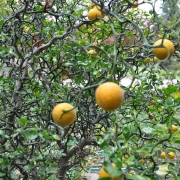Nuts for Fruits
What a fool I am; I can’t even follow my own advice! A couple of days ago I planted an apricot tree that I had ordered a few weeks previously. All of which compounds my foolishness because I had plenty of time to ponder the purchase, even cancel it if I came to my senses before it’s arrival mail-order.
Planting an apricot tree may not seem foolish to you. But it is, as I’ve advised many people. The reason is that here in the northeast, perhaps even east of the Rocky Mountains, an apricot is unlikely to bear fruit. The plant hails from regions where winters are steadily cold and spring temperatures creep steadily upward. Over most of continental U.S., winter temperatures fluctuate wildly up and down, predisposing the plants to
 |
| My apricot hope for the future. |
disease such as ominous-sounding, and truly debilitating, valsa canker. Trees typically die either quickly or slowly.
If only that were all . . . Apricot blossoms open at the first hint of spring warmth. The pinkish buds unfolding against the brownish red stems are a beautiful and welcome sight on the heels of winter, but those early blooms could — usually are — knocked out by subsequent frosty weather. Damaging, late frosts are least likely to occur near large bodies of water, such as the ocean and Great Lakes. Late frosts are most likely to occur in low-lying regions into which cold air sinks on still, spring nights; that would be here on my farmden in the valley of the Wallkill River.
If only that were all . . . Even if the trees stay alive through winters and their blossoms escape spring frosts, the fruits themselves are the target of a number of insects and diseases. Plum curculio, oriental fruit moth, brown rot, black knot . . . the list goes on of afflictions that can reduce the crop to zero. Oh, and did I mention squirrels. My father had a tree that every Father’s Day was stripped of every one of its small, green developing fruits by squirrels.
—————————————————-
Did you ever taste a perfectly ripened apricot, one that’s soft and ready to travel no more than arm’s length from the branch to your mouth? I have (when I worked at the USDA Fruit Laboratory and at a friend’s orchard; he has a good site). Perfectly ripe, the fruit tastes nothing like a lemon, as market apricots usually do, but has just a hint of tartness to offset its rich, sweet flavor. For that, I planted the tree.
 |
| My friend Lev with his apricot trees |
I wrote that “apricot is unlikely to bear fruit.” “Unlikely” does not mean “never.” A crop of apricots even one year out of — say — every five years will justify, for me, the space and trouble the tree will entail.
I was smart in a couple of ways with my apricot tree. I bought it from a nursery that specializes in fruit trees (www.cumminsnursery.com) and I planted in full sun in well-drained, moderately fertile soil. And the variety is Jerseycot, one of the varieties most resistant to some of the pests and the vagaries of our winter and spring weather.
——————————————————
More foolishness: I just received a confirmation for a nursery order, soon to arrive, that includes a camellia bush. Let me explain. I love living in the northeast but do bemoan the inability to grow certain plants not hardy here, among them southern magnolia, citrus, and camellia. I’ve been tempted to plant the hardiest southern magnolia, Edith Bogue, but
 |
| My “citrus” plantation. |
restrain myself realizing that the plant might survive but would never become a majestic specimen the tree is meant to be. Citrus? I resign myself to growing some citrus in pots, indoors in winter and outdoors in summer.
The last few years have seen the development of hardier camellias. Long Island Pink is one of the hardiest, with compact stature, glossy evergreen leaves, and single pink flowers in autumn. Still, it’s not really hardy here. I’ll plant it in the partial shade near the northeast corner of my home, protect it through winter its first few years as it develops cold-hardiness, and perhaps my foolishness will pay off.






Lee,
I was watching an old BBC documentary called Victorian Garden. In in they were growing tender fruits against south facing brick wall to capture heat and speed growth. I started thinking about how stone acts as a heat sink and it occurred to me that stone also captures cold. The cement floor in my cold cellar at this time of year is always a great deal cooler than the same floor just outside the cold cellar door.
I wonder if burying a large rock a foot or two below the bottom of the hole before planting an apricot would provide a cold sink that would trick the tree into “thinking” that it’s colder than it actually is, thus delaying the sap flow.
We have a couple of Manchurian apricots. One is planted out and the other is in a trench layering bed so that I can produce more trees & rootstock. There is a an apricot growing next to the Capilano Expressway in Edmonton in Alberta, Canada. Periodically, it fruits. I have a friend in Edmonton who sent me scion wood which I’ll graft onto the Manchurian in the orchard. As soon as there’s a new Manchurian apricot available from the layering bed, I’ll plant it in a hole with a large rock below it. Then I’ll take some Capilano scion wood from the orchard tree and graft on to it. That’ll give me two Capilano’s – one with a cold sink and one without.
And I’ll paint the trees with a white latex paint since there’s some evidence to suggest that this helps as well.
Regards,
Mike
I don’t think the large rock plan will work. The soil itself is a cold sink; I’m not sure how much more (or less) of a sink the rock would be. Also, keeping the roots cool does not necessarily have great affect on dormancy of the stems. Roots don’t have a dormancy.
The white latex paint — dilute it with equal parts water — should help a lot to keep the branches asleep later into spring.
There is a man in La Crosse, WI that has had good luck with Tomcot, as far as cold-hardiness and late bloom. I do not know what disease pressures he has faced or how he has treated it. But he claims to get fruit nearly every year. I’ve taken my chances on the Chinese (Mormon) apricot. It was just put in last spring, so we will see how it does long-term.
The good news here? Seeing an expert succumb to the same “I know it’s a bad idea, but I gotta have it!” mentality that the rest of us do! 😉 I’ve got three 2-n-1 japanese plum trees from Stark Bros that I KNEW I shouldn’t plant because they would be likely to have their blooms trashed by frost, and sure enough – they bloomed for the first time last year and I had zero fruits. Right now they’re COVERED in blooms, and I keep reminding myself I knew this was a risk, I knew I probably wouldn’t get much from them, and I was ok with it at the time of ordering.
It’s a little harder to accept when you see all these beautiful blooms and know some could be tasty fruit later in the year. 😉
I can’t imagine Camelias upstate! They have a hard enough of a time here in Atlanta; most years the majority of the flowers are blackened by a late frost and leaves are bronze from the same.
Your probably right. I couldn’t resist. But this is one of the hardier ones and I did plant it in an ideal spot. Still . . .
A couple of years ago, Northern Gardener Magazine had an article about a family in Minnesota who had quite a bit of success growing apricots. I think he had a sizable collection of varieties, too. I sympathize with the desire to beat the odds.
I may know that apricot grower through NAFEX, North American Fruit Explorers, an organization of fruit nuts such as myself.
Apricots tolerate quite a lot of cold weather. The limitation on growing them is fluctuating winter temperatures, late spring frosts, and, during the growing season, insects and diseases. So Minnesota apricot growing is feasible, especially near one of the many large lakes, which would moderate swings in temperatures.